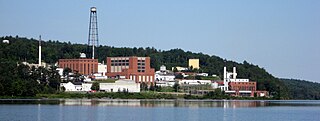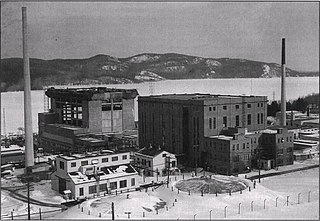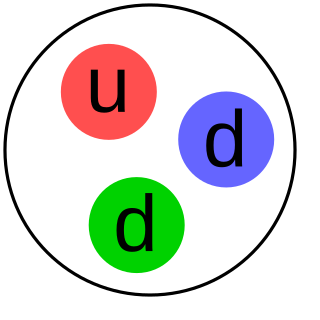
The CANDU is a Canadian pressurized heavy-water reactor design used to generate electric power. The acronym refers to its deuterium oxide moderator and its use of uranium fuel. CANDU reactors were first developed in the late 1950s and 1960s by a partnership between Atomic Energy of Canada Limited (AECL), the Hydro-Electric Power Commission of Ontario, Canadian General Electric, and other companies.

Chalk River Laboratories is a Canadian nuclear research facility in Deep River near Chalk River, about 180 km (110 mi) north-west of Ottawa.
Atomic Energy of Canada Limited is a Canadian federal Crown corporation and Canada's largest nuclear science and technology laboratory. AECL developed the CANDU reactor technology starting in the 1950s, and in October 2011 licensed this technology to Candu Energy.

Point Lepreau Nuclear Generating Station is a nuclear power station located 2 km northeast of Point Lepreau, New Brunswick, Canada. The facility was constructed between 1975 and 1983 by NB Power, the provincially owned public utility.

Gentilly Nuclear Generating Station is a former nuclear power station located on the south shore of the St. Lawrence River in Bécancour, Quebec, 100 km north east of Montreal. The site contained two nuclear reactors; Gentilly-1, a 250 MW CANDU-BWR prototype, was marred by technical problems and shut down in 1977, and Gentilly-2, a 675-MW CANDU-6 reactor operated commercially by the government-owned public utility Hydro-Québec between 1983 and 2012. These were the only power generating nuclear reactors in Quebec.

The ZEEP reactor was a nuclear reactor built at the Chalk River Laboratories near Chalk River, Ontario, Canada. ZEEP first went critical at 15:45 on September 5, 1945. ZEEP's was the first operational nuclear reactor outside the United States.

Research reactors are nuclear reactors that serve primarily as a neutron source. They are also called non-power reactors, in contrast to power reactors that are used for electricity production, heat generation, or maritime propulsion.
The National Research Universal (NRU) reactor was a 135 MW nuclear research reactor built in the Chalk River Laboratories, Ontario, one of Canada’s national science facilities. It was a multipurpose science facility that served three main roles. It generated radionuclides used to treat or diagnose over 20 million people in 80 countries every year. It was the neutron source for the NRC Canadian Neutron Beam Centre: a materials research centre that grew from the Nobel Prize-winning work of Bertram Brockhouse. It was the test bed for Atomic Energy of Canada Limited to develop fuels and materials for the CANDU reactor. At the time of its retirement on March 31, 2018, it was the world's oldest operating nuclear reactor.

The Whiteshell Laboratories, originally known as the Whiteshell Nuclear Research Establishment, or WNRE for short, was an Atomic Energy of Canada (AECL) laboratory in Manitoba, northeast of Winnipeg. It was originally built as a home for the experimental WR-1 reactor, but over time came to host a variety of experimental systems, including a SLOWPOKE reactor and the Underground Research Laboratory to study nuclear waste disposal. Employment peaked in the early 1970s at about 1,300, but during the 1980s the experiments began to wind down, and in 2003 the decision was made to close the site. As of 2017 the site is undergoing decommissioning with a planned completion date in 2024.
ZED-2 is a zero-power nuclear research reactor built at the Chalk River Laboratories in Ontario, Canada. It is the successor to the ZEEP reactor. Designed by AECL for CANDU reactor support, the unit saw first criticality on 7 September 1960. The reactor is still operating at Chalk River where it is used for reactor physics and nuclear fuel research.
The Advanced CANDU reactor (ACR), or ACR-1000, is a Generation III+ nuclear reactor designed by Atomic Energy of Canada Limited (AECL). It combines features of the existing CANDU pressurised heavy water reactors (PHWR) with features of light-water cooled pressurized water reactors (PWR). From CANDU, it takes the heavy water moderator, which gives the design an improved neutron economy that allows it to burn a variety of fuels. It replaces the heavy water cooling loop with one containing conventional light water, reducing costs. The name refers to its design power in the 1,000 MWe class, with the baseline around 1,200 MWe.
Nuclear Power Demonstration was the first Canadian nuclear power reactor, and the prototype for the CANDU reactor design. Built by Canadian General Electric, in partnership with Atomic Energy of Canada Limited (AECL), Ontario Hydro and the US Atomic Energy Commission (AEC), it consisted of a single 22 MWe pressurized heavy water reactor (PHWR) unit located in Rolphton, Ontario, not far from AECL's Chalk River Laboratories. NPD was owned by AECL and operated by Ontario Hydro.
The Douglas Point Nuclear Generating Station was Canada’s first full-scale nuclear power plant and the second CANDU pressurised heavy water reactor. Its success was a major milestone and marked Canada's entry into the global nuclear power scene.
Nuclear power in Canada is provided by 19 commercial reactors with a net capacity of 13.5 gigawatt (GW), producing a total of 95.6 Terawatt-hours (TWh) of electricity, which accounted for 16.6% of the country's total electric energy generation in 2015. All but one of these reactors are located in Ontario, where they produced 61% of that province's electricity in 2019. Seven smaller reactors are used for research and to produce radiopharmaceuticals for use in nuclear medicine.
The Whiteshell Reactor No. 1, or WR-1, was a Canadian research reactor located at AECL's Whiteshell Laboratories (WNRL) in Manitoba. It was built to test the concept of a CANDU-type reactor that replaced the heavy water coolant with an oil substance. This had a number of potential advantages in terms of cost and efficiency.

The Nuclear Power Plant in Cernavodă is a nuclear power plant in Romania. It produces around 20% of the country's electricity. It uses CANDU reactor technology from AECL, using heavy water produced at Drobeta-Turnu Severin as its neutron moderator and as its coolant agent. The Danube water is not used for cooling of the active zone.
CANFLEX; the name is derived from its function: CANDU FLEXible fuelling, is an advanced fuel bundle design developed by Atomic Energy of Canada Ltd. (AECL), along with the Korean Atomic Energy Research Institute (KAERI) for use in CANDU design nuclear reactors. The designers claim that it will deliver many benefits to current and future CANDU reactors-using natural uranium or other advanced nuclear fuel cycles. These include greater operating and safety margins, extended plant life, better economics and increased power.

Nuclear industry in Canada is an active business and research sector, producing about 15% of its electricity in nuclear power plants of domestic design. Canada is the world's largest exporter of uranium, and has the world's second largest proven reserves. Canada also exports nuclear technology within the terms of the Nuclear Non-proliferation Treaty, to which it is a signatory, and is the world's largest producer of radioactive medical isotopes.

Thorium-based nuclear power generation is fueled primarily by the nuclear fission of the isotope uranium-233 produced from the fertile element thorium. According to proponents, a thorium fuel cycle offers several potential advantages over a uranium fuel cycle—including much greater abundance of thorium found on Earth, superior physical and nuclear fuel properties, and reduced nuclear waste production. However, development of thorium power has significant start-up costs. Proponents also cite the low weaponization potential as an advantage of thorium due to how difficult it is to weaponize the specific uranium-233/232 and plutonium-238 isotopes produced by thorium reactors, while critics say that development of breeder reactors in general increases proliferation concerns. As of 2020, there are no operational thorium reactors in the world.

SNC-Lavalin Group Inc. is a Canadian company based in Montreal that provides engineering, procurement, and construction (EPC) services to various industries, including mining and metallurgy, oil and gas, environment and water, infrastructure, and clean power. SNC-Lavalin is the largest construction company, by revenue, in Canada, as of 2018. The firm has over 50,000 employees worldwide, with offices in over 50 countries and operations in over 160 countries.











